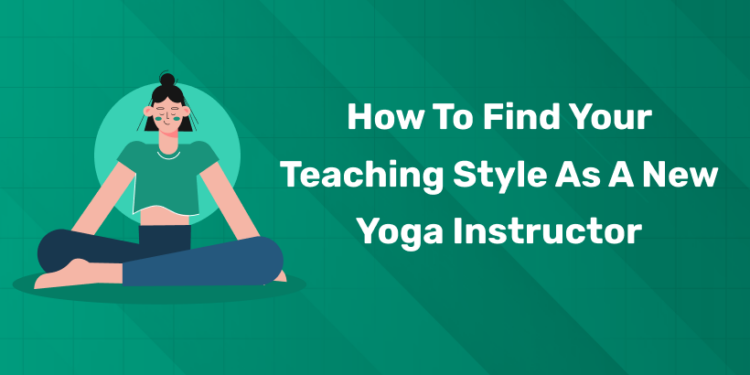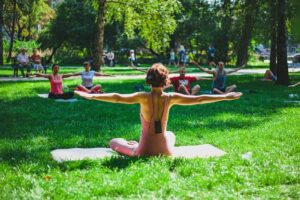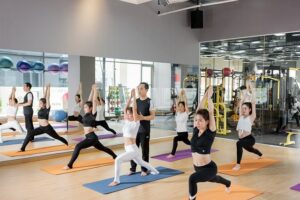Table of Contents
One of the biggest things that new yoga teachers are fighting for is to find their individual style of teaching. Although it is normal to imitate the style of your teachers when you first start, your teaching should also come from you.
Of course we can and should be inspired by our favorite teachers, but that does not mean that we should simply copy them. The more you try to imitate other teachers, the less natural it will feel and your students will pick it up.
Every yoga teacher is unique and this individuality is what does yoga class so enriching. The development of personal style of teaching will not only help you excel, but also increases your authenticity and creates a deeper connection with your students. When you teach in a way that feels true, your passion is shining and your students feel it.
Yoga Teacher Training – Learn from Experienced Instructors! Get Free Demo Here!
Identify Your Strengths and Teaching Personality
Identify Your Strengths
Perhaps the most common approach to finding a good career is to identify your personal strengths and then look for ways that match them.
The greatest risk is to reduce your current strengths and ignore your potential to develop new, stronger strengths. This risk is the most urgent for younger people who do not yet have much data about what they are good at – which is more often incorrect – and have decades to develop new strengths.
- Do not focus only on what will become good today. The career has been taking place for decades and you have the potential to develop new strengths.
- Look at your work history, but be careful not to rule out too early. Take a look at your improvement compared to others with a similar level of experience and training than your absolute performance.
- What you consider to be energetic and motivating is also essential in determining your strengths. In the university it is possible to take place well on an object that you do not consider to be energizing, but it is difficult to keep it for 10 years or more. What does not feel like work (but is)?
- Get feedback. The negativity of distortion and acquaintance blinds us to our strengths, so the request for others is one of the most useful ways to learn about yourself. We included some examples.
- In general, think about what counts as strength. Consider relationships, sources and reputation, as well as skills and abilities – within these, consider personality, cognitive abilities and character traits. Like tasks, think about what contexts, cultures and types of people are best coincided.
- Get specific. Look back at your calendar in the last few weeks. Which activities did you consider the most energetic?
- Combine and combine. Think about how to combine strengths and create rare but useful combinations. Look for strengths that you can constantly improve for decades.
- Browse lists of strengths developed in psychological research that we attached at the end. Unfortunately, these qualities do not look in a simple way to your likely performance compared to tasks. But they correlate weakly and look like the most well -designed categories we have.
Identify Your Teaching Personality
You love children
It is almost obvious, but a good teacher will have true love for children and will be happy to help learn and prosper. If you are the type of person who is happiest when you work with children, you can teach for you!
You have respect for children
It is hard to teach someone who feels that you do not respect them, and small children are surprisingly good to recognize these things. If you have real respect for children and their potential, he studied in his early childhood, it is definitely worth considering.
You have a lot of patience
Parents who have only one child need a lot of patience in dealing with their small ones. Multiply it by 20 or more children and you can see how much patience you need to teach young children. You will need a long fuse and the ability to handle a wide range of patience testing events.
You can easily handle stressful situations
This feature goes hand in hand with the previous one. Even the best classes of young children will have stressful situations. Unpleasant children, injuries and accidents and conflicts between students are just some of the problems you will certainly face as a teacher. You must be able to deal with these situations while keeping your peace.
Yoga Teacher Training – Learn from Experienced Instructors! Get Free Demo Here!
Building Confidence In Your Teaching Style
1. Be prepared
Planning involves predicting the problems of specific classes, ensuring that you are ready to observe lessons, potential situations that could arise and how you could deal with them. If your trust has been knocked down, try to insert some extra preparation time. But … try to allow some flexibility to avoid panic if you need to change part of the track!
2. Walk tall
Body Speech says a lot! It affects how others see us and how we see each other. In her interview, the social psychologist Amy Cuddy claims that “strength performs” – confidently, even if we don’t feel it – can increase your sense of self -esteem and may have an impact on our chances of success. People who are afraid or sure have a tendency to struggle or crouch, so walking will give you the air of confidence.
3. Your classroom, your rules
- Your lesson begins when your students learn at you. So if they are waiting outside your class, start a lesson. They calmly and confidently demand the behavior you expect from them before they come, greet them at the door and immediately set expectations.
- If you start to feel panic or lose control, for a while and breathe. Take a look at your lesson plan and after you feel more relaxed, try to get control of the lesson calmly and authoritatively.
- Finally, if the class just doesn’t listen, don’t try to scream for them. It quickly frustrates and anger and will not encourage your class to listen. Instead, try to stand (despite how you can feel inside) and wait. In the end, the class will be silent, it does not have to happen immediately, but to be patient.
4. Don’t fear criticism, use it
If you have received some feedback you consider negative, use it as a tool to change. By acting on criticism instead of getting up in it, you can turn negative into positive, which will help you not only build confidence, but also really improve your practice.
5. Steer clear of Negative Nellie’s
Will you find yourself surrounded by teachers who complain and moan on everything? Although all teachers face challenges, it does not help to concentrate on them in a negative way. If you notice that people around you are always winged, change around. Look for those teachers who try to be and are positive about your work.
6. Realise your strengths
Last but not least, last but not least, take some time to think about your practice and pull out positives. Try to shoot a lesson for a really lens lens in your practice.
Integrating Philosophy and Mindfulness
If mindfulness procedures are integrated into the classroom, students can benefit in different ways, including cultivating durable skills previously known as “soft skills”:
- Emotional regulation: Imprincy techniques teach students to effectively recognize and manage their emotions. This can lead to improving behavior, reducing impulsivity and better decision -making skills.
- Focusing and attention: The practices of mindfulness, such as conscious breathing or scan the body, can improve students’ ability to concentrate and focus on tasks. This can lead to improvement of academic performance and productivity.
- Reduction of stress: The school environment can sometimes be stressful for students. Mindfulness helps them to cope with academic pressure, social challenges and personal problems by encouraging them to remain present at the moment, reduce the anxiety and level of stress.
- Improved cool: Regular practice of mindfulness was associated with improved mental health results, including lower depression and anxiety. By promoting emotional well -being, schools can create a more positive and careful educational environment.
- Increased self -confidence: mindfulness promotes self -reflection and awareness of its thoughts, feelings and feelings. This self -confidence can lead to improving self -esteem, greater empathy and better relationships with others and deeper understanding of yourself.
- Building resistance: Teaching causes students to deal with challenges and failures more efficiently. By strengthening resistance, students can reflect from difficulties and failures with greater force and flexibility.
Overall, the integration of mindfulness in the classroom helps students develop basic life skills that not only benefit their academic performance, but also support their overall well -being and success in the future.
Practical ways to integrate mindfulness during the school day
The integration of the classification in the classroom can be performed in different ways and includes formal and informal practices. Here are some practical examples of how to integrate mindfulness into your class or school to raise permanent skills:
- Breathing exercises: Like Fabiola’s School, you can start a day with a short mindful respiratory exercise. Let the students sit quietly and focus on your breath for a few minutes and bring their attention back whenever their mind wandered.
- Listening activities: Involve students in mindful listening activities by playing soothing music or sounds. Ask students to listen carefully and share their observations and encourage them to be fully present at the moment.
- Movement breaks: Incorporation of short mindful movement throughout the day. It could be simple sections, yoga poses or observant walking, which will help students release tension and re -focus their energy.
- Grateful magazines: Encourage students to maintain grateful magazines where they can write things that are grateful for each day. This practice promotes positivity by allowing them to focus on the current moment and recognize the positive aspects of their lives.
- Scanning of the body: Do an average activity for scanning the body where students close their eyes and focus on different parts of your body, notice any feelings or feelings without judgment. This can help support the awareness of the body and relaxation.
- Reflection: At the end of the day, facilitate the reflective session where students can share their experience, emotions or observations throughout the day. This encourages them to have their thoughts and feelings of self -confidence and mindfulness.
With just a few minutes of mindfulness during the school day, teachers can create a care environment in which students can cultivate the basic life skills that benefit their overall well -being, academic success and future career.
Conclusion
Balance of yoga teaching methods is essential for a successful yoga teacher. This includes understanding different teaching methods and knowing when to use them based on the needs of your students. As a yoga teacher, it is necessary to have compassion for your students and create engaging classes that maintain interest and motivated.
In addition, the inclusion of new techniques into your learning can increase your students’ experience and provide opportunities for growth as a teacher. Balance of traditional and modern approaches can help you attract beginners and experienced practices.
In short, mastering the art of balancing yoga teaching requires time, patience, practice and observation skills. With regard to these aspects, when you teach each class, you can create an environment in which everyone feels welcome and at the same time brings stunning results to satisfy all parties – from beginners of yogis to experienced veterans!
Yoga Teacher Training – Learn from Experienced Instructors! Get Free Demo Here!
Frequently Asked Questions
How do I market myself as a new yoga teacher?
- Why do I need to worry about marketing for my yoga classes? …
- Grow your student base. …
- Activate your personal network. …
- Collect email addresses and send newsletters. …
- Have a marketing strategy. …
- Target your audience with the right media.














